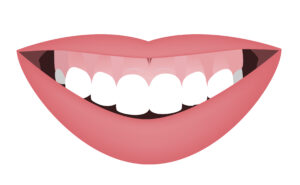Header logo
header top contact widget
periodontal plastic surgery
Choose A Periodontist To Correct A Gummy Smile
Posted on Aug 29, 2022 by William J. Claiborne, DDS MS
About Periodontal Plastic Surgery
When Lauren Hutton, the model well-known for a space between her front teeth, began modeling, she felt she needed to camouflage the gap (or “diastema”). Yet, she soon began to feel it was a unique feature that set her apart from the others. She was right, and now at the age of 77, she’s been on more front covers than nearly any other model.
Each smile is unique. Hopefully, your smile makes you feel good every time you share it. And, the very act of smiling has been shown to release endorphins in the brain. Those are the chemicals that create a bit of a ‘natural high.’ Smiling is obviously an asset to our well-being.
If you have a “gummy” smile, you may be perfectly fine with it. After all, it is not detrimental to oral health if you care for your gums properly (which goes for everyone). And, it can be a positive part of your personality. Katie Couric has a gummy smile and shares hers openly.

“Gummy” Smile
However, not everyone with this trait feels comfortable with the look nor the way it makes them feel when smiling. Some people tend to suppress a full smile. Others often conceal their smile with a hand when smiling fully or laughing. Some people smile with their lips only.
A gummy smile, in the periodontal specialty, is known as EGD, an abbreviation for excessive gingival display or a gingival smile (GS). The trait occurs more often in females than in males. (Gingival is of or relating to the gums.)
Esthetically, a balanced smile typically shows the front top 6 or 8 teeth. Arching each tooth, there is generally minimal gum tissues showing , and sometimes none. Another esthetic complement to a smile is having gum tissues that show a slight arch over each tooth at a similar line as those that arch adjacent teeth. Gums that are lower over one or two teeth tend to create a jumbled look in a full smile.
When the height of gum tissues distract from the appearance of a smile, a periodontist is your expert. This dental specialist has specialized skills in all aspects of oral tissues. Through their advanced training, they are able to safely and beautifully reshape the tissues that surround teeth.
For people who wish to have a gummy smile or uneven gum line re-contoured, a periodontist performs a gingivectomy. A gingivectomy is a procedure during which excess gum tissue is remove. During this, the gumline is sculpted to give your smile balance with a more even smile line.
In addition to repairing a gummy smile, a gingivectomy is involved in a procedure known as crown lengthening. Crown lengthening involves removing the excessive gum tissue to expose more of the crown of the tooth, as well as sculpting the gumline to make it higher up. After the gum tissues are shaped, a crown is typically placed to protect the tooth above the gum line and to create a more beautiful smile.
A crown lengthening may also help to save a tooth from removal. When a tooth breaks off near the gum line, a crown lengthening can be performed to expose a sufficient amount of the tooth’s base so it can support a crown.
Another procedure a periodontist expertly performs is gum grafting. This is often to cover exposed roots, to reduce further gum recession, protect vulnerable tooth roots from decay, and improve your smile. Recession can occur as a result of periodontal disease, which causes tooth roots to become exposed and makes the teeth look long.
Gum tissues are very tender tissues with many nerves. Procedures that involve the gums must be performed with precision to minimize discomfort and speed healing time. A periodontist excels in the skills to create an optimal outcome with the most conservative treatment needed.
Our Asheville periodontal dental office provides some of the most advanced imaging and computerized technology available. This includes cone beam 3D imaging and laser dentistry. Additionally, we provide oral and IV sedation (“twilight sleep”) so patients are able to relax or snooze comfortably while being monitored by specially-trained team members who use advanced safety equipment.
Begin with a consultation with an experienced periodontist, who can answer your questions thoroughly and determine the best treatment option for your individual needs. Call 828-274-9440.
Some sources:
https://www.colgate.com/en-us/oral-health/mouth-and-teeth-anatomy/3-treatment-options-for-a-gummy-smile
https://www.researchgate.net/figure/Female-and-male-percentages-in-the-gummy-smile-sample_tbl1_340258838
Our Asheville Periodontal Dental Office Offers Some Unique Services
Posted on Jun 13, 2022 by William J. Claiborne, DDS MS
As a Periodontist in Asheville, I’ve helped hundreds of patients overcome periodontal (gum) disease and the many repercussions that come with tooth loss. Helping to save teeth that were on the verge of requiring removal has also been a victory for the patient as well as me.
 I take great pride in being a part of the transformations of patients who achieve healthy, confident smiles. This is why I’ve created an environment that affords every patient with the most advanced options available for restoring oral health and replacing lost teeth with dental implants.
I take great pride in being a part of the transformations of patients who achieve healthy, confident smiles. This is why I’ve created an environment that affords every patient with the most advanced options available for restoring oral health and replacing lost teeth with dental implants.
Let me begin by clarifying the benefits our periodontal office brings…
• A periodontist has advanced training to properly diagnose and treat all stages of gum disease.
• We are known for never over-treating or under-treating with a commitment to provide the most successful treatment for each patient’s specific needs.
• Our periodontal office is specially equipped for the diagnosis and treatment of all stages of gum disease as well as placement of dental implants.
• Diagnosis and treatment planning is backed by an immense array of advanced technology, including:
-
- LANAP (Laser-Assisted New Attachment Procedure) with PerioLase MVP 7 – an advanced protocol that efficiently and effectively treats advanced gum disease with the added advantages of a dental laser. This offers a non-surgical alternative for patients with moderate to severe periodontal disease and has even been found to stimulate bone regrowth in damaged areas.
- 3-D Cone Beam Imaging – is ideal for diagnoses and treatment planning through images that provide a clear view of the upper and lower jaw (including nerve canals), with rotations that show sagittal, axial, and coronal planes in a process that is quick, painless and at minimal radiation levels.
- CareStream Cone Beam Computer Tomography Imaging – is enhanced tomography that works with 3D imaging for exceptional detail and range.
- CS 3600 Intraoral Scanner – quickly and comfortably captures digital impressions to accurately and easily create precision models or appliances (crowns, inlays, onlays, bridges, orthodontic appliances, aligners, custom abutments) without the need for bulky, goopy trays.
- Computerized Dental Implant Placement – an advanced system for pre-surgical positioning of dental implants using a 3D model of the patient’s jaw. Once the implant type is selected, a template is developed for optimal treatment success.
• A commitment to comfort including I.V. sedation (twilight sleep) as well as oral sedation for total relaxation. On our team is a Board Certified Anesthesiologist to provide sedation and anesthesia for optimal comfort and safety.
Treatment options in our specialty dental office also include reshaping gum tissues for esthetic enhancement (crown lengthening, gingivectomy for ‘gummy smiles’, repairing areas of gum recession); diagnosis and placement of dental implants; and treatment of lesions or cysts in oral tissues.
With specialized skills, a periodontist is especially respectful to oral tissues as tender layers that significantly affect the appearance of a smile and the health of teeth. Utilizing special skills to minimize incisions while effectively treating each area in the mouth, a periodontist is your expert.
Call 828-274-9440 to learn more or to schedule a consultation appointment. New patients are always welcome and a referral is not required.
Many Reasons To Repair Gum Recession
Posted on May 19, 2022 by William J. Claiborne, DDS MS
If you are occasionally experiencing sensitivity around one or more teeth, especially when eating ice-cream or drinking hot coffee, this is likely due to receded gums.
While using a sensitivity toothpaste can somewhat minimize these sensations (which can become painful jolts), the problem will remain. The source of sensitivity, most often, is because the highly-sensitive tooth’s root area has been exposed by the pulling away of gum tissues.
The gum tissues are designed to provide a tight seal around the base of each tooth, which blocks bacterial entry to the sensitive tooth root area. In addition to sensitivity, recession means oral bacteria can penetrate beneath the gum’s surface. Once beneath the surface, the accumulating presence of this bacteria can lead to inflammation of the gums.
Eventually, the infectious bacteria attack the structures that support natural teeth. This bacteria indicates the presence of periodontal (gum) disease. Signs and symptoms of gum disease in its first stage include:
• Gum tissues that turn red
• Gums that become tender or swollen
• Gums that bleed when brushing
• Persistent bad breath
Obviously, it’s important to ensure the gums are healthy so the grip they have around teeth is snug. It’s also important to be aware of the causes of gum recession. These are:
The aging process – As people age, their gums become drier. This causes them to shrink and be less capable of keeping a secure grip around the base of teeth.
Periodontal (gum) disease – As mentioned above, gum disease destroys oral tissues and the bone that supports natural tooth roots. A sign of periodontal disease is gum recession. Gum disease is also the nation’s leading cause of adult tooth loss.
Poor dental hygiene – When twice-daily brushing, daily flossing, and keeping the mouth moist are insufficient to rid the mouth of bacteria, their accumulation can result in the sticky film you feel on teeth. This is plaque. In just a day or so, plaque can harden on teeth into tartar. This is a cement-hard bacterial colony that cannot be removed by brushing or flossing . It can only be removed during a professional tooth cleaning. If not removed, teeth, gums and the structures below the gum line can be damaged.
Brushing too hard – Brushing teeth rigorously doesn’t mean you are doing a good job. Using a scrubbing, back-&-forth motion can wear away tooth enamel and cause the gums to recede. Other damaging actions when brushing are or using a hard bristled toothbrush or abrasive substances, such as baking soda.
Hormones – Females experience fluctuations in estrogen levels during puberty, menstrual periods, pregnancy and menopause. During these times, the gums can be more sensitive and vulnerable to gum recession.
Tobacco use – In addition to the many health hazards smokers risk, they are more likely to develop plaque due to the oral drying effects of smoking. This dryness can lead to gum recession (not to mention brown teeth and bad breath).
Bite misalignment – When teeth don’t come together evenly, too much force can be exerted on the gums and surrounding bone, allowing gums to recede. Bite misalignment can also lead to grinding or clenching teeth. These harsh forces on teeth can cause the gums to loosen their grip.
If you have mild sensations of sensitivity, desensitizing toothpastes can help soothe the nerves by forming a protective barrier over teeth while blocking sensitivity signals. Although this type of toothpaste can be helpful, it should be used as a temporary aid.
The goal should be to repair recession and halt the problem from recurring. To do this, we begin by determining why the gum recession is occurring. The next step is to restore the gums to their proper positions.
The corrective procedure most often performed is a “gingivectomy” performed by a periodontal specialist. In addition to treating all stages of gum disease, a periodontist specializes in contouring gum tissues. Using advanced skills, a periodontist is able to create a natural look and restore your oral health.
A gingivectomy can reposition or graft gum tissues over the area of recession to restore a healthy seal and protect the tooth structures below the surface.
Another advantage of a gingivectomy is to help save a natural tooth. When a tooth breaks near the gum line, a “crown lengthening” procedure may be advised. In this, a periodontist may be able to expose enough of the tooth structure for the placement of a crown.
A crown lengthening procedure is an ideal accompaniment to many cosmetic dentistry treatments. When there are different heights of gum tissues framing the teeth most visible in a smile. This tends to create a jumbled looking smile, when when the teeth are straight.
Crown lengthening rebalances the height of gum tissues that arch the teeth to restore a smile that is balanced. From this, the eye is drawn to the smile as a whole rather than one or two teeth with varying heights of gum tissue.
 A gingivectomy is also performed for individuals who wish to correct a “gummy smile.” This is when a smile shows too much gum tissue above upper teeth when smiling fully.
A gingivectomy is also performed for individuals who wish to correct a “gummy smile.” This is when a smile shows too much gum tissue above upper teeth when smiling fully.
Gingivectomies are performed while the patient is comfortably numbed. For some people, sedation may be a preference for enhanced relaxation. Oral sedation is available in pill form, which allows patients to ‘doze’ through procedures. I.V. sedation, also known as “twilight sleep”, is available for patients who prefer a deeper level of sedation.
Both sedations are administered by fully trained team members who use advanced safety monitoring equipment. We believe your safety is as important as your comfort.
In our Asheville periodontal dental office, we also offer a wide array of technology. This often saves the patient time in treatment, enhances comfort, and speeds healing. For example, our dental laser can seal tissues as it contours it. This eliminates or greatly minimizes bleeding.
Pain is how the body indicates that something is wrong. When the gum tissues have receded, they are not going to repair on their own. Let’s discuss your particular needs, whether for improved oral health or to enhance the appearance of your smile (or both) during a consultation appointment.
Call 828-274-9440 to schedule a time.
April is National Oral Cancer Awareness Month
Posted on Apr 12, 2022 by William J. Claiborne, DDS MS
April is recognized as National Oral Cancer Month. It provides an annual opportunity for the medical and dental communities to remind the American population of the dire consequences that can be brought on by this cancer.

Oral cavity and oropharyngeal (which includes the base of the tongue and soft palate) cancers occur most often in the tongue, gums, floor of the mouth, tonsils, and other parts of the mouth and oropharynx. These cancers also occur in the lips and salivary glands (typically those in the roof of the mouth).
According to the American Cancer Society’s, recent statistics of oral and oropharyngeal (throat) cancers include:
• In 2022, an estimated 54,000 new cases will occur with about 11,230 deaths.
• The average age of people diagnosed with these cancers is 63, but over 20% (1 in 5) of cases occur in patients under the age of 55.
• These cancers are more than twice as common in men as in women and slightly more common in white people than black people. Overall, the lifetime risk of developing oral cavity and oropharyngeal cancer is about 1 in 60 for men and 1 in 140 for women.
Although the death rate and new cases of oral cavity has risen only slightly over the past 20 years, there has been an increase specifically in oropharyngeal cancers associated with an human papillomavirus (HPV) infection in both men and women. These HPV-positive cancers tend to act differently than HPV-negative cancers.
A number of other factors can affect your risk for developing mouth and throat cancer. These include:
Tobacco and alcohol use – Tobacco use is one of the strongest risk factors for head and neck cancers, including oral cavity and oropharyngeal cancer. The risk for these cancers is much higher in people who smoke than in people who don’t. Most people with these cancers have a history of smoking or other tobacco exposure, like chewing tobacco. The more you smoke, the greater your risk. Smoke from cigarettes, pipes, and cigars all increase your risk of getting these cancers. Some studies indicate that long-term exposure to secondhand smoke might increase the risk of these cancers. 
Oral tobacco products (snuff, dip, spit, chew, or dissolvable tobacco) are linked with cancers of the cheek, gums, and inner surface of the lips. Using oral tobacco products for a long time is linked to a very high risk. These products also cause gum disease, destruction of the bone sockets around teeth, and tooth loss.
For people who continue to smoke and use oral tobacco products after cancer treatment, their risk of developing a second cancer in the mouth, throat, larynx (voice box), lung and other organs greatly increases.
Drinking alcohol increases the risk of developing oral cavity and oropharyngeal cancers. Heavy drinkers have a higher risk than light drinkers. Smoking and drinking alcohol together multiplies the risk of these cancers. The risk of these cancers in people who drink and smoke heavily is about 30 times higher than the risk in people who don’t smoke or drink.
Human papillomavirus (HPV) infection – HPV is a group of more than 150 types of viruses called papillomaviruses. Some of these viruses cause a type of growth commonly called a papilloma or wart.
Infection with certain types of HPV can cause some forms of cancer, including cancers of the penis, cervix, vulva, vagina, anus, mouth, and throat. HPV type 16 (HPV16) is the type most often linked to cancer of the oropharynx, especially those in the tonsil and base of tongue.
The number of oropharyngeal cancers linked to HPV has risen greatly over the past few decades due to becoming more common in younger people who have a history of multiple sex partners (including oral sex). This is true for even those with no history of alcohol abuse or tobacco use.
Gender – Oral cavity and oropharyngeal cancers are twice as common in men than in women. HPV-related oropharyngeal cancers are also seen more often in men.
Poor nutrition – Studies have found that a diet low in fruits and vegetables is linked with an increased risk of cancers of the oral cavity and oropharynx.
Being obese or overweight – Too much body weight appears to increase the risk of these cancers. It is advised that eating more plant-based foods, such as non-starchy vegetables and whole fruit, may help people lose weight as well as reduce their risk of oropharyngeal and laryngeal cancer.
Age – Because oral and oropharynx cancers can take many years to develop, they’re not common in young people. Most patients with these cancers are older than 55 when the cancers are first detected. HPV-linked cancers tend to be diagnosed in people younger than 50.
Sunlight – Cancers of the lip are more common in people who have outdoor jobs where they are exposed to sunlight for long periods of time.
Genetics – People with certain genes have a higher risk of mouth and middle throat cancer.
Signs and symptoms of mouth cancer may include:
• A lip or mouth sore that doesn’t heal within two weeks
• White or reddish patch on the inside of the mouth
• Loose teeth
• A growth or lump inside the mouth
• Mouth pain
• Ear pain
• Difficult or painful swallowing
Although oral cancer may first make itself known by a spot on the lips, inside of cheeks or on (or under) the tongue, oropharyngeal cancer can exist without symptoms. When symptoms do arise, they may be:
Mass felt in the neck or in the back of the throat
Difficulty or pain with swallowing
Muffled voice
Ear pain
Throat pain or sore throat
A periodontist is a dental specialist who has advanced skills in treatment involving the gums, including gum disease, gum reshaping and in the placement of dental implants. This specialist can also detect suspicious areas that may be early warning signs of oral or oropharyngeal cancer. Through a painless process, the examination can determine is a biopsy is needed for a thorough testing process. The earlier the treatment, the less involved the process will be. Too, early treatment helps to increase survival rates.
As an Asheville NC periodontal specialist, please react promptly to any signs or symptoms associated with these cancers. And, with this knowledge, make it your goal to share this information with a smile you love.
Recent Posts
Categories
Archives
- September 2024
- August 2024
- July 2024
- June 2024
- May 2024
- April 2024
- March 2024
- February 2024
- January 2024
- December 2023
- November 2023
- October 2023
- September 2023
- August 2023
- July 2023
- June 2023
- May 2023
- April 2023
- March 2023
- February 2023
- January 2023
- December 2022
- November 2022
- October 2022
- September 2022
- August 2022
- July 2022
- June 2022
- May 2022
- April 2022
- March 2022
- February 2022
- January 2022
- December 2021
- November 2021
- October 2021
- September 2021
- August 2021
- July 2021
- June 2021
- May 2021
- April 2021
- March 2021
- February 2021
- January 2021
- December 2020
- November 2020
- October 2020
- September 2020
- August 2020
- July 2020
- June 2020
- May 2020
- April 2020
- March 2020
- February 2020
- January 2020
- December 2019
- November 2019
- October 2019
- September 2019
- August 2019
- July 2019
- June 2019
- May 2019
- April 2019
- March 2019
- February 2019
- January 2019
- December 2018
- November 2018
- October 2018
- September 2018
- August 2018
- July 2018
- June 2018
- May 2018
- April 2018
- March 2018
- February 2018
- January 2018
- December 2017
- November 2017
- October 2017
- September 2017
- August 2017
- July 2017
- June 2017
- May 2017
- April 2017
- March 2017
- February 2017
- January 2017
- December 2016
- November 2016
- October 2016
- September 2016
- August 2016
- July 2016
- June 2016
- May 2016
- April 2016
- March 2016
- February 2016
- January 2016
- December 2015
- November 2015
- October 2015
- September 2015
- August 2015
- July 2015
- June 2015
- May 2015
- April 2015
- March 2015
- February 2015
- January 2015
- December 2014
- November 2014
- October 2014
- September 2014
- August 2014
- July 2014
- June 2014
- May 2014
- April 2014
- March 2014
- February 2014
- January 2014
- December 2013
- November 2013
- October 2013
- September 2013
- August 2013
- July 2013
- June 2013
- May 2013
- April 2013
- March 2013
- February 2013
- January 2013
- December 2012
- November 2012
- October 2012
- September 2012
- August 2012
- July 2012
- June 2012


